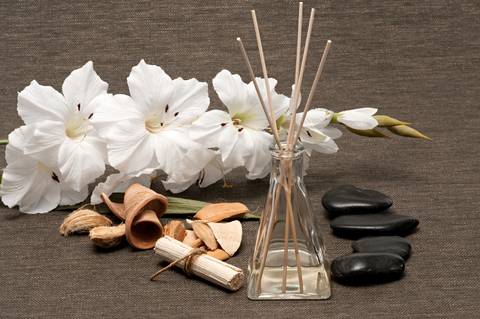There’s no big secret lurking in a lab somewhere on how to make reed diffuser oil. In fact, it’s easy to make reed diffuser oil, but there are a couple of things that are important to understand first. The purpose of this post is to shed a little light on the misinformation about reed diffuser oil scattered around the internet.
You must use oil that will wick (move) up the reeds or the diffuser won’t work correctly. No wickey, no diffusey.
Adding essential oil(s) or fragrance oils to dipropylene glycol is the most common method used to make reed diffuser oil. If a heavy essential oil is used, perfumer’s alcohol is added to further dilute the oil so it will effectively wick (move up the reed).
You can make reed diffuser oil that’s absolutely perfect, but it will do you absolutely no good if you aren’t using reeds that wick. Tree limbs, Popsicle sticks, bamboo “reeds”, wooden chopsticks etc. won’t work because they lack the porosity to work correctly. I recommend rattan reeds. I don’t know if you could use balsam wood or not. It’s certainly porous, but whether it would wick well or not is the question. I might give it a try sometime down the road. However, balsam is expensive and rattan reeds are not. Maybe I won’t try it.
Easy To Make Reed Diffuser Oil
You will add the following to your diffuser (the jar or bottle that holds the oil):
1 oz of essential oil or fragrance oil
2 ½ ounces of Dipropylene Glycol (cosmetic grade)
¼ ounce perfumer’s alcohol (for heavy essential oils)
This recipe makes 3 ¾ ounces of oil. You can double or triple the volume depending on the size of your diffuser. Take one of your reeds and stir ingredients. Add reeds and allow them to become soaked with the oil then turn them over so the wet portion is above the diffuser. That’s it.
Tips:
- When the scent becomes faint, turn the reeds. You’ll probably want to do this about once a week.
- Don’t try and reuse the reeds. Once the oil is used up, add new reeds even if you’re using the same essential oil(s).
- Adding pure essential oil(s) offers therapeutic benefits that fragrance oils lack.
- You can use 100 proof vodka as a substitute for perfumer’s alcohol.
- As an alternative, you can make reed diffuser oil by using grape seed or jojoba oil instead of ethylene glycol, but your diffuser won’t wick as well. If you do elect to go this route, I would definitely add the alcohol to the mixture.
Now that you can see how easy it is to make reed diffuser oil, there’s no excuse not to be enjoying the wonderful fragrances and the therapeutic power of essential oils all the time. However, if you don’t have the inclination to do so, you can buy reed diffuser oil base to which you add the essential oils you choose. Your hobby store may have it on hand or you can purchase it online.
P.S. Did you know that a published article in the April 2009 edition of “letters in Applied Microbiology” reported and 89% reduction in airborne bacteria of an office that used a diffuser with Egyptian geranium (graveolens) and lemongrass (citratus).
Now go have fun and relax.
Related articles:
Cinnamon Oil – Oh So Sexy Reed Diffuser


Hi there guest,
Try using the dipropylene glycol in your diffuser in place of oil. That should solve the rancidity problem. I’m not sure what tiny critters, if any are working on the reeds. I would probably replace them as they started to discolor. You might also think about using an electric diffuser if this problem persists. Let us know how things work out for you.